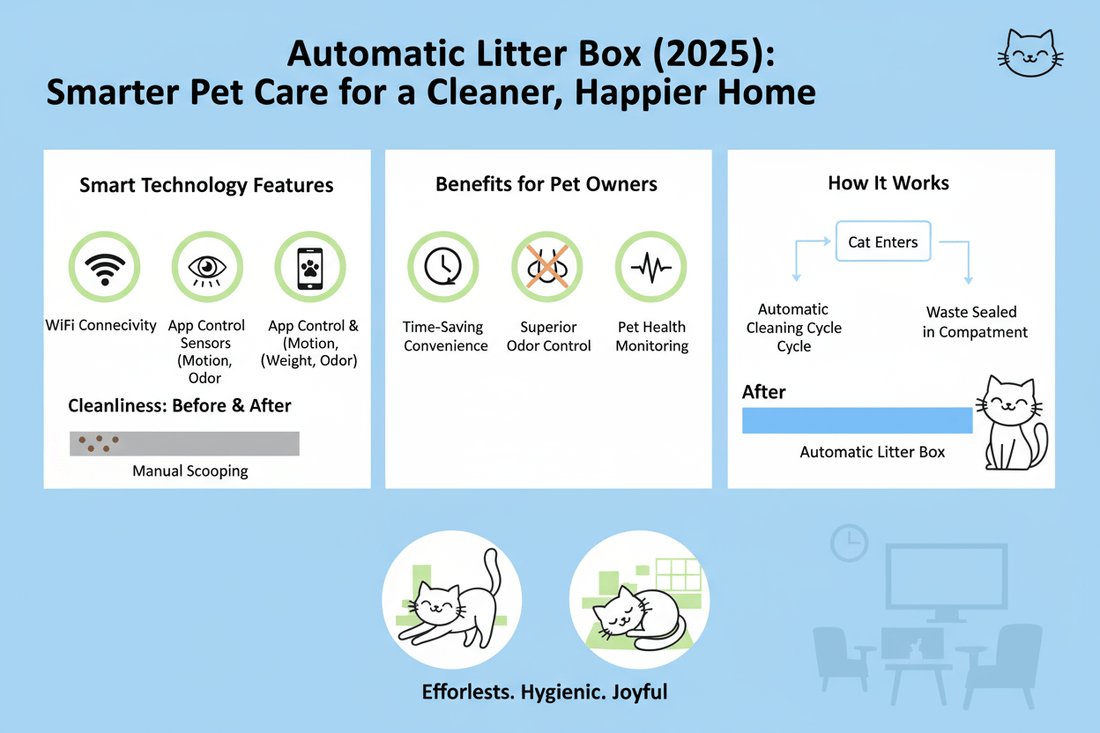
Automatic Litter Box(2025): Smarter Pet Care for a Cleaner, Happier Home
Share
What does an automatic litter box do?
An automatic litter box, sometimes called a self-cleaning or smart cat litter box, uses built-in sensors to detect when your cat finishes using it. The box then automatically separates and disposes of waste—keeping the litter area fresh without daily scooping.
Today’s cat owners are embracing automation not just for convenience, but for their pets’ well-being. A consistently clean litter box helps reduce odor, stress, and the spread of bacteria—while giving you back valuable time each day.
Why more cat owners are switching to Automatic Litter Box
For busy households or multi-cat families, an automatic litter box is a small investment that transforms daily pet care.

Studies from PubMed highlight that cats prefer clean boxes and may avoid dirty ones, making automated cleaning an important factor in feline health and comfort.
Modern smart litter boxes use sensors and rotating or raking systems to separate waste, seal it in odor-resistant bins, and reset the box with clean litter. According to a 2025 report from Grand View Research, this market continues to grow as smart-home adoption expands, reaching over $550 million globally and expected to rise steadily each year.
How a Automatic Litter Box actually works
- Sensor activation: The system detects when your cat exits the box and waits a short delay before cleaning.
- Self-cleaning cycle: Waste is raked or rotated into a sealed compartment.
- Odor control: Built-in filters and enclosed waste bins minimize smell.
- App connectivity: Some models, like the Famistar Smart Cat Litter Box, let you track usage or trigger cleaning from your phone.
Everyday benefits you’ll notice
Owning a self-cleaning cat litter box brings noticeable lifestyle improvements:
- Less daily work: Spend less time scooping and more time enjoying your cat.
- Better hygiene: Frequent cleaning helps reduce bacteria and allergens in the home.
- Fresher air: Automatic waste sealing helps eliminate lingering odors.
- Reduced stress for cats: A clean, consistent litter box encourages healthy habits and fewer accidents.
Choosing the right automatic litter box
Before purchasing, consider a few important points:
| Feature | What to look for |
|---|---|
| Box size | Large enough for your cat to move comfortably. |
| Safety sensors | Ensure cleaning stops if your cat re-enters. |
| Waste bin capacity | Essential for multi-cat households. |
| Noise level | Look for quiet or delayed cleaning cycles. |
| App & WiFi control | Allows monitoring and scheduling remotely. |
Why the Famistar Automatic Litter Box stands out
The Famistar Automatic Litter Box combines large capacity, quiet operation, and reliable sensor-based safety. It offers a fully automated experience that suits single or multi-cat homes alike.
- 65 + 15 L total capacity—ideal for households with multiple cats.
- Smart app control via 2.4 GHz WiFi for cleaning, tracking, and odor management.
- Comprehensive safety protection: motion sensors, anti-pinch system, and pause-on-entry.
- Odor-locking sealed drawer and modern design that fits comfortably in any room.
It’s a great choice for pet owners seeking modern convenience without compromising on safety or space.
Setup and maintenance tips
- Place the litter box in a quiet, ventilated corner with easy access for your cat.
- Introduce it gradually—allow your cat to explore before activating automatic cleaning.
- Use familiar litter at first to ease the transition.
- Empty the waste drawer and clean sensors weekly to keep performance smooth.
- Monitor early reactions—most cats adjust quickly when the box is calm and consistent.
Common Questions
How often do you need to empty an automatic litter box?
Typically every 3–5 days for a single cat, depending on model and bin size. Large-capacity models like Famistar can go longer between disposals.
Can it handle more than one cat?
Yes, many models—including Famistar—are designed for multiple cats and adjust cleaning frequency accordingly.
Is it safe for kittens or small cats?
Smart sensors prevent operation while the cat is inside. However, it’s best to wait until kittens are at least 3 months old before introducing an automatic system.
Does an automatic litter box eliminate all odors?
While it greatly reduces them, occasional maintenance is still needed. Keeping the filter and waste drawer clean ensures lasting odor control.
Final Thoughts
An automatic litter box doesn’t just automate cleaning—it improves the entire pet-care experience. A cleaner box means a calmer cat, a fresher home, and one less daily chore to worry about. If you’re ready to modernize your pet routine, consider a trusted, safety-focused model like Famistar for a seamless upgrade.


